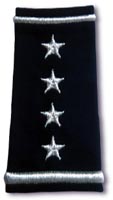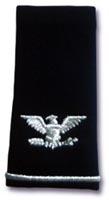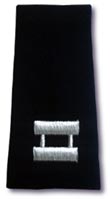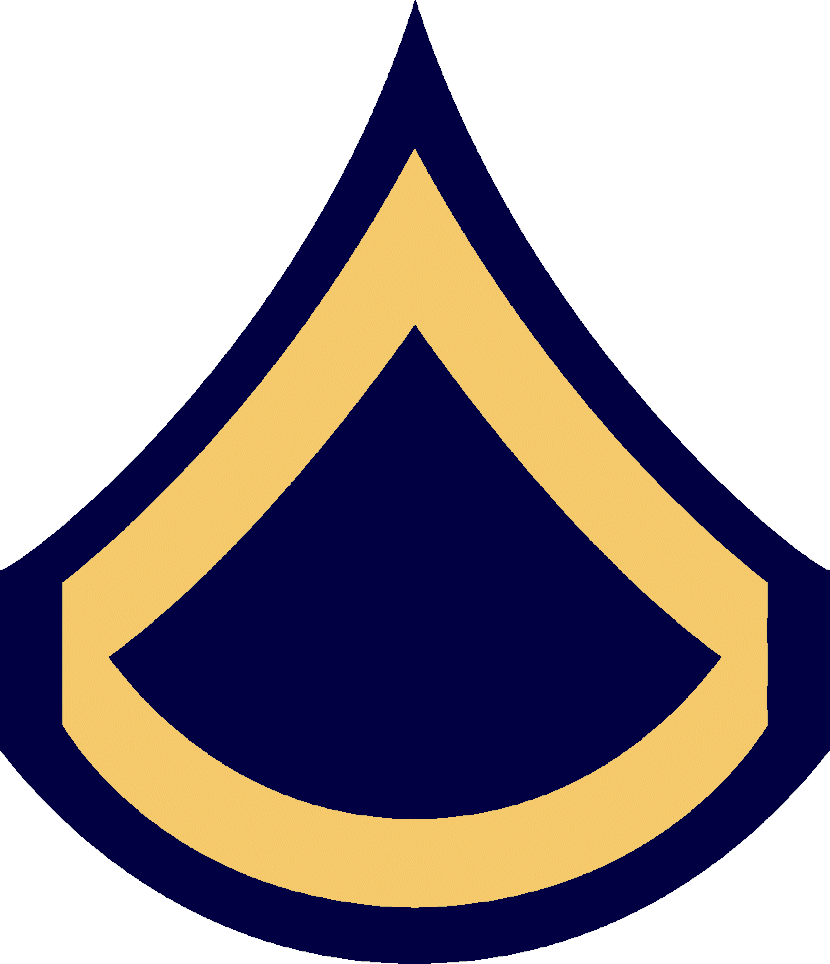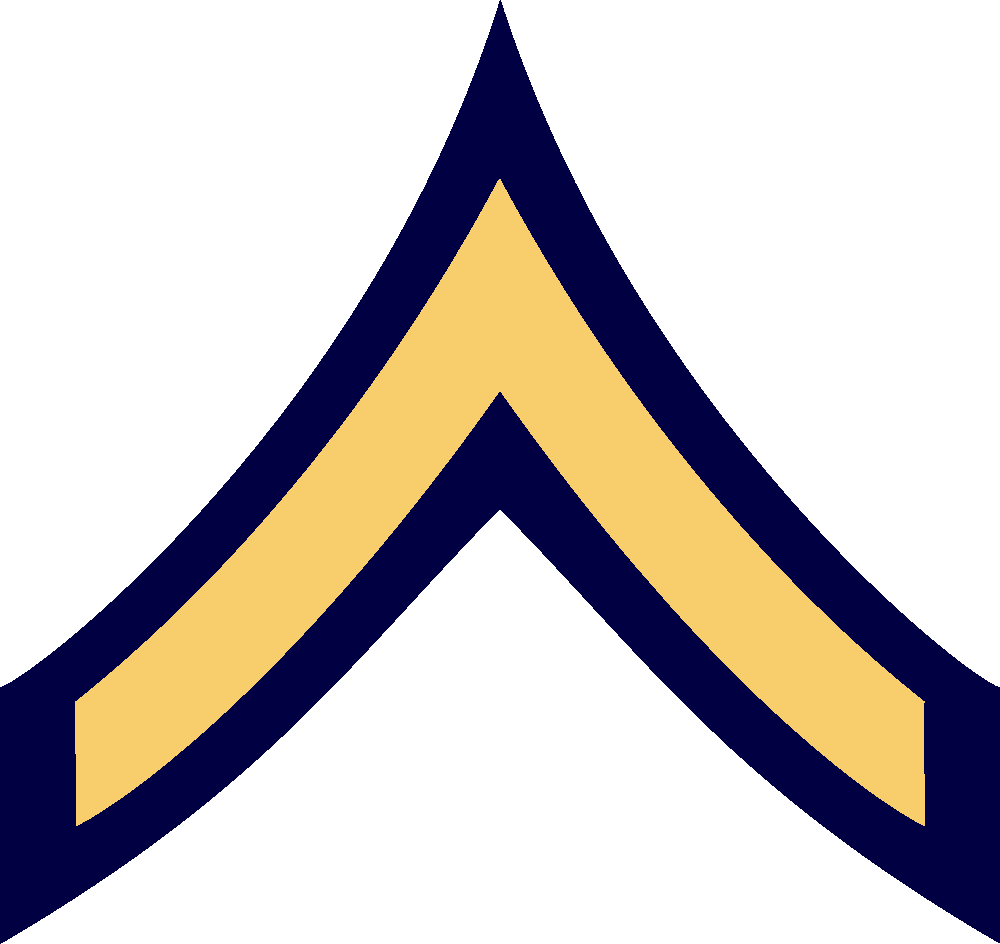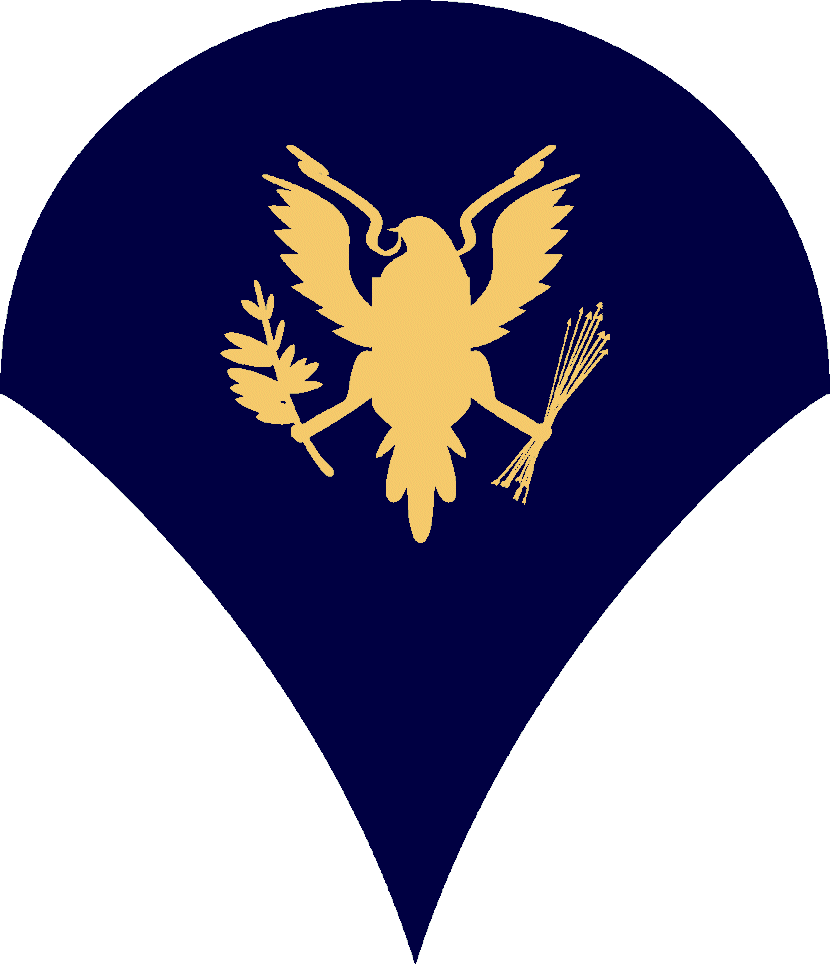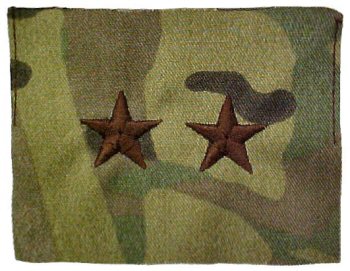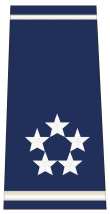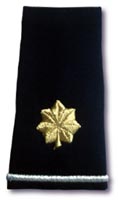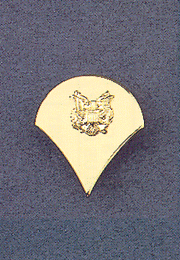| UNRESTRICTED |
|---|
|
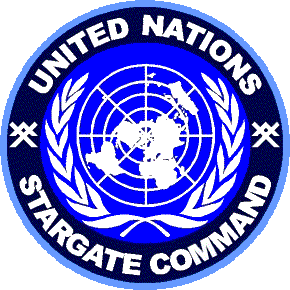
|
1. Rank & Insignia |

| |||||||
|---|---|---|---|---|---|---|---|---|---|---|
PrefaceBefore you start reading these pages, you might like to first visit Handout #03<> (link above), to get a print out of the rank insignia as used by the UNMC/UNSGC.
The purpose of military rank in regular forces is to provide a clearly visible system of management, through what is called the Chain Of Command. Officers, normally the more highly qualified personnel, make the decisions that subordinates then carry out. However, the UNMC functions far more like modern Special Forces formations rather than it does ordinary regular line units. The distinctions between Officers and Enlisted personnel, and indeed the various consequential ranks within these categories, are extremely blurred. All have similar backgrounds/qualifications, and are expected to demonstrate leadership capabilities, self-discipline and independence/initiative. This is due in large part to both the Corps' highly varied and flexible role, and the resulting profiles of its recruits. Most have been either mid-ranked Commissioned Officers, Captains, Majors, Lieutenant Colonels, Naval Lieutenants and Commanders. Alternatively they may have served as senior Non-Commissioned Officers (NCOs), that is Chief Petty Officers, Warrant Officers, Platoon or Master Sergeants. They can also be highly qualified civilians drawn from positions of great skill/responsibility in academic, scientific, medical, and industrial fields. More importantly, unlike any other military forces, it needs to permit its experienced personnel the opportunity to switch back and forth between being a commissioned or non-commissioned officer as circumstances demand, a system which will be explained below. Therefore to a large extent there is a levelling out effect in play, essential with such an eclectic and talented grouping. This leads to an absence of the "us and them" atmosphere often encountered in regular service between officers and enlisted ranks. Yesterday's subordinate can very quickly become tomorrow's superior, a fact that severely tempers officer-NCO relationships. See Commissions & Transfers. The essential difference in the UNMC between Commissioned Officers and Non-Commissioned Officers is that NCOs focus upon immediate tactical considerations, whereas officers focus upon the long term strategic objectives. This means that officers are inevitably involved in long hours of study and paperwork between operations, in addition to other duties, such as recruitment service and on-base support work. In practise the division is again blurred, but the emphasis is indicated. However, the officer does ultimately carry more responsibility for the long term success of a campaign, and so this is where the buck will finally stop. Thus like most Special Forces, when time permits, unit members will make their decisions collectively, personnel only resorting to pulling rank when either a consensus is unobtainable, time is critical, or the planned actions have a bearing upon the campaign at a strategic level. Usually, expertise in a given field is the criteria for decision making, not rank. It is not uncommon to see units, with a mix of various officers and Sergeants, working perfectly well together with a humble Private in charge of a given task, because he or she is the expert. All this is reflected in the Corps' promotion system in that the points required for example to be a Captain are exactly the same as that for a Staff Sergeant (6,000). Promotional Points (PP) are earned through the factors of time/experience within UNMC service, and more importantly, upon the type of service rendered. In many ways rank is regarded as often nothing more than a job description, except when the situation requires its imposition. If an issue does arise that must be resolved by rank, then, in the case of a tie, seniority in time served at that rank takes precedence. NB: that officers who behave as though they are still in a regular line formation, or otherwise abuse this arrangement, will find themselves at the very least with a reprimand, via being decommissioned/demoted, through to, at the worst, being dismissed from the service.
Ranks fall in to the following catogories:
The non-command authority rank of "Specialist" and "Embedded Civilian/VIP*" are included here below Private, because these personnel are outside of the normal chain of command. * Very Important Person
Be aware, that due to the unique nature of UN operations it is not recommended to enter the field without the appropriate rank insignia. Remember the maxim "no insignia, no rank, no authority!" The actual insignia worn is US Army issue, with the exception of the officers' Shoulder Marks (epaulette slides), which are drawn from the US Air Force. Their blue background helps to distinguish officers from NCOs whose Shoulder Marks are black. For non-combat duties and more formal ocasions, personnel wear a pair of bright metal "pin-on" insignia, in either silver or brass as appropriate to rank, on each epaulette of their Service Dress Uniform (SDU) black jacket. When permitted to wear "garison" caps (aka "side" or "airborne" caps) rather than the regulation UN blue beret, it is common practise for Marines to attach their rank insignia to its right hand side opposite the UNMC badge on the left (when available). In the case of Colonels and higher ranks these are of a special minature size.
For officers these marks are in white or gold (depending upon rank), on a dark blue background. General's have additional narrow stripes, one at the base and another at the top of the shoulder mark, while Major's and Colonel's have only a single narrower one at the base. Captains, Lieutenants and NCOs have no stripes at all. NCOs, that is Corporals to Command Sergeant Majors, have gold (yellow) insignia embroiderd on a Shoulder Mark in a greenish-black background. The different colours and additional stripes aid in recognition at distance.
Note that Marines attending their very first operation, serve at the rank of "Private Recruit" aka "Rookie", and like civilians and VIP's, wear no rank insignia what so ever. Upon satisfactory completion of their first operation, they are confirmed as a Marine Private, and authorised to wear a single chevron.
Alternatively subdued metal matt black or brown/green painted pin-on insignia, as shown below, or in the Rank Quick Ref Guide can be used. These latter are identical in form to the bright versions shown in the illustrations above and on the Rank & Insignia Tables page.
The UNSGC General Staff Posts In theory the General Staff is made up of each of the commanders of the eight Star Gate bases, the commanders of the fifteen Branches of Service (BOS), the Commander-In-Chief, their Chief-of-Staff, and six special appointments which are numbered G1~G6, as listed below. The General Staff would then consist of 30 General Officers, plus their Aide-de-Camps. In practise the Corps is far too small to warrant such a top heavy command structure, and so the General Staff is limited to between 7~11 persons at a time, meaning most hold more than one post, and certain branch and G# posts are automatically twinned. Promotion here, does to a large extent depend upon the old adage of "filling dead man's", or indeed "woman's", "- shoes".Here is a full list of the theoretical individual positions:
Five other posts are designated by a alpha-numeric code. The letter "G" for General is used for these positions within the General Staff at Brigade level and above as previously mentioned, while a letter "S" for Staff is used at Regimental level and below. The numerical order is not indicative of command authority, the posts are neutral in that respect. The 6 posts are:
The remaining post is that of the Chief Medical Officer, who is responsible for on-base management of medical services and maintenance of the medical database.
Unqualified civilians or VIPs who may from time to time be attached to units are otherwise required to be accompanied by Close Protection Officers (CPOs) acting as body-guards, creating significant limitations to mission profiles. The CPO's are normally (where available) ex-Law Enforcement Officers (LEO), trained in VIP/Principal handling/protection drills. They are normally fully qualified Marines, but sometimes they are Specialists, and are specifically assigned as escorts for our civilian staff and VIPs in potentially hostile environments. In the case of Specialists, VIPs and civilians, their title abbreviations are commonly suffixed with a number which are used to clarify seniority issues within their class. For example: "SPEC7", "VIP7", "CIV7" or "CIVI7". As stated above, in emergencies Specialists outrank both VIPs and civilians regardless of paygrade, and simillarly VIP's always outrank all other civilians. Caution: Be aware that VIP's and some civilians tend to have great influence on the CONTACT Program, and care by military personnel in their handling is highly recommended. Moving from Civilian to Specialist to MarineServing civilian staff, may at any point apply for Specialist training, and upon successfull completion of the ten week course be appointed as a UNMC Specialist. Likewise, Specialists who wish to transfer to full time military service, may at any time attempt to pass the 2 week selection board, after which they must complete an additional eight weeks of basic military training. Precise starting pay/rank is in part dependent upon their prior UNMC service record. Such training is undertaken between operations, so as not to interrupt the campaign.PromotionsAll former military, para-military and LEO's commence their service by enlisting in the Corps as a Private (PVT) soldier, regardless of prior experience or branch of service (Army, Navy, Coast Guard, Marines or Air Force etc.).Rank is a function of the number of Promotional Points (PP) earned through service, with the ranks from Private First Class through to General having other specified requirements for eligibility, such as the minimum number of required Expert Infantry Course Units, see the table below. Promotional Points are acrued by various factors including: time served (campaigns/operations/missions,days), degree of service (dificulty/unpleasantness/danger), and type of service rendered (training/tactical/strategic). EICU points are achieved by passing through the designated training programmes, often popularly but irroniously called "boot camps". Your personal connduct, warnings/reprimands, awards and medals are also taken into account. Progress, tends to be steady, and unlike the majority of military forces your promotion is not on the whole dependent upon vacancies at a given rank. As to how long it takes to rise through the ranks, it purely depends upon your service record. However as a very rough guide, under peacetime conditions it could take as much as twenty years to reach the absolute top of your career path, that is Command Sergeant Major or General of the Marine Corps), whereas in time of continuous conflict, it could take as little as just five years. A fulltime operative will earn between 1,500 and 2,500 points per year, depending upon if it is peacetime or wartime service. This figure excludes any points earned as the result of an award of a Decoration. NB: currently the UNSGC is working under "wartime" conditions. It requires 2,000 Promotional Points and 12 Expert Infantry Course Units to become eligible for either the rank of Corporal or Second Lieutenant, and 18,000 PP plus 72 EICU to reach the rank of Colonel or Sergeant Major. For a complete copy of your service record (201 File), including all points earned to date, click this link to your unit's Active & Reserve Duty Roster , find your name, click it and see your file. Alternatively to compare your performance with other Marines, see the Awards Granted website, and go to Table 11 at the bottom of the page. See also the associated Decorations, Medals & Awards pages to see the various criterias. Table 1 below shows the basic PP and EICU requirements for each rank: Qualifying Points* Note that promotion to the ranks marked with an asterisk depend upon vacancies within your unit, or other postings. | |||||||||||||||||||||||||||||||||||||
| ||||||||||||||||||||||||||||||||||||||||||||||||||||||
|
Promotion is neither automatic nor mandatory, as the Promotions Board exercises a great deal of discressionary authority. Therefore, just because you have earned the points, it doesn't mean that you have earned the promotion. Nor, on the other hand, do you have to accept it, if one is offered. Likewise as mentioned above you can apply for a commission, or to be decommissioned.
As all officer, and the higher NCO ranks are in part dependent upon the maintainance of a number of key qualifications, involuntary decommissioning can also occur. This happens when an officer, ceases to qualify for their position, and consequencially is returned to the enlisted ranks. True demotions occur only by order of a Courts Martial, conveened under regulations by the senior personnel of your unit, and then ratified by, or otherwise ordered by a General Staff Officer, usually for disciplinary reasons. However in special circumstances, you can be voluntarily demoted within your career path, for example from Sergeant to Private First Class, this is sometimes done to reduce stress created by workload, usually by order of a Medical Officer. Often in these perculiar circumstances the pay grade is not reduced, or if it is, not to the full extent. The other ocaision wherein a demotion is mandatory is when a transfer from one sub-command to another is required of, or requested by, a serving Marine. For example when one who is stationed at a US base requests transfer to another base or even one in a different country. Upon acceptance personnel suffer a non-permanent, long term minus one to their earned rank grade, resulting in a reduction in both rank and pay. They are then assigned to their new post's Military Police Company (MPC) to serve as a Security Guard performing such duties as perimeter patrols, while being orientated to their new station and awaiting Flight Status to be granted. Repeated transferrs incur further cumalative penalties. This is done to discourage these kinds of "transfers", as it can take many months or even a year or more for personnel to become fully familiarised with their new assignment. Please note that units rarely accept such transfers unless they are suffering a shortage of personnel, for example due to casualties (KIA, MIA). See the Commissions & Transfers Tables page to see how this works. Achieving Senior RankOnce a Marine has achieved a minimum of 2,000 Promotional Points (PP), plus a minimum of 12 Expert Infantry Course Units (EICU), and is ready to be promoted above the rank of Private/Private First Class, a decision is made as to which career path is initially taken, that is as either a Commissioned or Non-Commissioned offeicer.To serve as a Non-Commissioned-Officer (NCO) at the ranks of Corporal through to Command Sergeant Major, you must first satisfy the Promotional Points requirements and the Expert Infantry Course Unit minimums specified for each rank as shown in the Qualifying Points Table above. To achieve the higher grades, that is Sergeant First Class and above, a candidate must also perform other duties such as in recruitment and on-base Work Details between operations. The rank of First Sergeant is not specified in the above qualifying points table as it is an appointment, and the required qualifications are not absolutely fixed. However, in general the candidate would be required to have a minimum of 18,000 PP and at least 36 EICU before being considered for the post. To serve as a Commissioned Officer, that is at the ranks Second Lieutenant through to General of the Marine Corps, you must in addition to satisfying the Promotional Points requirements and the Expert Infantry Course Unit minimums specified for each rank as shown above, also pass the following additional qualifying requirements:
The above requirements are subject to the Promotion Boards adjudication, and may be waived. The Etiquet of RankIn most regular services it is customary for subordinates to automatically salute superior officers upon all occaisions. This practise can, in peacekeepping or war-fighting operations lead to the death or injury of crucial personnel, through ranged identification to hostile elements, therefore such practises are not required of UNMC personnel on a day to day basis. Salutes are only ever given or taken as a deliberate action in formal ceromonies or as an act of courtasy/respect in an appropriate situation. Be aware that repeated saluting out of these contexts is a chargible offence under UNMC Standing OrdersThe use of the verbal acknowledgements Sir and Ma'am are however normal. The uni-sex use of "Sir", is acceptable, particularly in situations where service equipment renders easy gender identification difficult or impossible. Specialists, and those from distinctly different military backgrounds are reminded that these modes of address are strictly for use when addressing a superior "Commissioned Officer" ONLY. It is not used when addressing a superior NCO. In these circumstances it is customary to use the NCOs abridged rank as the address. For example "Sergeant". If you make a mistake, the NCO WILL be happy to remind you of what is correct practise. A Brief Word On $ PayIn the UNMC all remuneration is provided in US dollars. Your pay and rank are connected through the Pay Grade system. However unlike the similar US pay grades, there is just a single scale used for all personnel working for the UNMC. It applies to civilians, VIPs, Specialists, NCOs and officers alike. The grades run from PG1 (Private), through to PG15 (General of the Marine Corps). Their value is a multiplier of the annually determined basic pay rate. So for example if at the time of the 2008 tour when the award was $330.00 per month, and you had been serving as a Sergeant, then your basic monthly pay would have been $330.00 × 5 = $1,515.00. In addition there are numerous allowances and other benifits which must be added, which results in the differences between the gross pay of a Private and a General being not as far apart as they would otherwise be in regular service. This arrangement reflects the Corps' recruiting policy, in that for it's soldiery only fully trained personnel with good prior military or equivalent experience are considered. Civilian pay runs the full range as per that of the military, however Specialists begin at PG4. You should be aware that your pay grade may be higher than that specified for your current rank, as Pay Grade and rank are not irrevocably locked together.In practise UNMC pay is regarded as adequate, when compared to other tier 1 units, especially when the reduced hazards is considered, but then the special psychological requirements due to the "weirdness" factor, is generally thought to trump, or at least match this. And finally, remember... |
....that today's subordinate can well be tomorrow's superior!
And lastly no insignia, no rank, no authority!
| Top |
|---|
END OF DOCUMENT
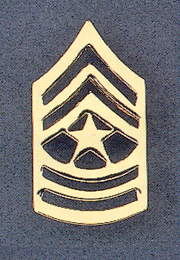 A Sergeant Major's bright metal pin-on insignia for wear on the Service Dress Uniform (SDU) black jacket and garrison cap.
A Sergeant Major's bright metal pin-on insignia for wear on the Service Dress Uniform (SDU) black jacket and garrison cap.
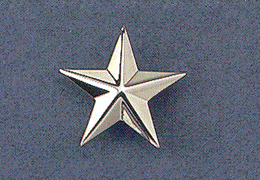 A Brigadier General's bright metal pin-on insignia for wear on the eppaulette of the SDU black jacket and garrison cap.
A Brigadier General's bright metal pin-on insignia for wear on the eppaulette of the SDU black jacket and garrison cap.
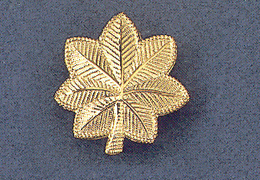 A Major's bright metal pin-on insignia for wear on the SDU black jacket and garrison cap.
A Major's bright metal pin-on insignia for wear on the SDU black jacket and garrison cap.
